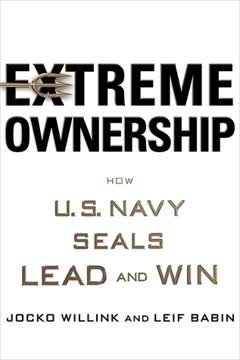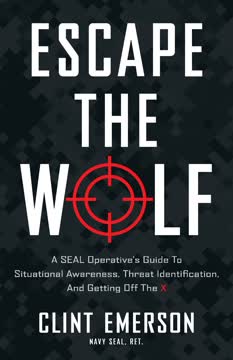Key Takeaways
1. From Mischief to Military Elite: A Rebellious Youth Finds Purpose
It was the risk itself I craved. And the worse the potential consequences, the bigger the payoff.
Early inclinations. Clint Emerson's childhood in Saudi Arabia as an "ARAMCO brat" was marked by unsupervised mischief, from setting fires to orchestrating "bat suicides" with darts. This environment fostered a deep-seated appetite for risk and a knack for deception, which he later recognized as foundational to his military career. His early exploits, like stealing from classmates, were driven by the thrill of the caper, not financial gain.
Foundational skills. Despite his rebellious streak, Emerson's time in the Boy Scouts provided surprisingly practical skills that would later prove invaluable. Activities like SCUBA certification, wilderness survival, and marksmanship laid a groundwork for his future as a Navy SEAL. These experiences, combined with a natural inclination for problem-solving and a desire for something more, set him on an unconventional path toward elite military service.
A turning point. A chance encounter at an airport with a man claiming to be a Navy SEAL, coupled with a computerized career assessment pointing to "underwater demolition," solidified his ambition. This pivotal moment shifted his focus from childhood fantasies of being a ninja to the tangible goal of joining the world's most elite fighting force. His journey highlights how innate traits, even mischievous ones, can be channeled for a greater purpose.
2. BUD/S: The Ultimate Mental Gauntlet
Everybody’s already done enough talking about how hard BUD/S is, and I’m not the first SEAL to say that the training is 90 percent mental, 10 percent physical.
Beyond physical endurance. BUD/S, the grueling six-month Navy SEAL training, is less about brute strength and more about psychological fortitude. Emerson emphasizes that success hinges on mental resilience, the ability to tune out distractions, and an unwavering refusal to quit, even when faced with extreme physical and psychological stress. His personal coping mechanisms included inappropriate laughter and secretly filming the torturous "evolutions."
The crucible of character. The training is designed to break individuals down and rebuild them as cohesive units. Emerson admits to a "twisted" satisfaction in seeing others quit, as each departure fueled his own determination. The process strips away individual differences, transforming diverse recruits into a unified force, where humility and a shared understanding of hardship replace ego.
Unconventional preparation. Emerson's prior experiences, from his Boy Scout diving skills to his teenage risk-taking, inadvertently prepared him for the unique challenges of BUD/S. He learned to regulate his output, live for the next meal, and find small ways to cope with relentless pressure. This mental toughness, rather than raw athleticism, proved to be the decisive factor in his graduation.
3. Warfare's Shifting Sands: Adapting to Unseen Threats
The world was a war zone, the threat a couple of men in a tiny boat.
From conventional to asymmetric. Emerson's early deployments, like the ship boardings in the Persian Gulf, were classic SEAL missions, but the USS Cole attack in 2000 marked a profound shift. A small fiberglass boat with explosives inflicted massive damage on a modern destroyer, revealing a new era of asymmetric warfare where the enemy was no longer a nation-state army but small, elusive groups. This forced the Navy to rethink its security protocols and operational focus.
Frustration with command. The initial stages of Operation Iraqi Freedom highlighted the disconnect between traditional military leadership and the evolving nature of conflict. Emerson's platoon, eager for direct action, was often held back by risk-averse commanders, leading to frustration and a sense of wasted potential. This experience solidified his belief that SEALs needed more autonomy and a "tell them what we did" approach to operations.
The new reality. The post-9/11 landscape demanded a new kind of operator capable of operating in ambiguous, high-threat environments. The focus shifted from large-scale combat to targeted intelligence gathering and advance force operations. This new reality meant SEALs would increasingly operate in civilian clothes, relying on discretion and unconventional tactics rather than overt displays of force.
4. Mastering the Art of Discretion: Infiltration and Deception
In the covert world, pulling your gun is beyond a worst-case scenario—it’s a sign that you’ve completely fucked up and utterly failed.
Beyond brute force. Emerson's transition to "sensitive programs" marked a pivot from direct combat to the subtle art of clandestine operations. His new role involved developing training pipelines for reconnaissance and advance force operations, emphasizing skills like lock picking, safe cracking, and vehicle manipulation. The goal was to gather intelligence without detection, making discretion paramount.
The magic of tradecraft. Drawing on his childhood experience as a magician, Emerson applied principles of misdirection and pattern disruption to real-world scenarios. His first solo op in Djibouti, involving the infiltration of a suspected Osama bin Laden boat, relied on simple "magic tricks" and exploiting human biases. This demonstrated that effective covert work often hinges on ingenuity and subtle manipulation rather than complex technology.
Blending in. Operating in foreign environments required a deep understanding of cultural nuances and the ability to blend seamlessly into the local population. Emerson experimented with various methods to reduce his visibility, from adopting a "Danish wildlife researcher" cover to using local attire. The ultimate aim was to become an "unseen hand," capable of influencing situations without revealing governmental involvement.
5. The Unseen Hand of Global Influence: Navigating Complex Geopolitics
Civilians may have been shocked to hear that we were listening in on our allies during that dustup with Angela Merkel’s phone back in 2013. But for members of the military and intelligence community, the only surprising thing about that piece of news was the fact that it got out to the general public.
A world of shadows. Emerson's work frequently involved navigating a complex web of international relations, where allies spied on each other and local forces often had their own agendas. His experience in Djibouti, where German forces were likely listening to French communications, underscored the pervasive nature of global intelligence gathering. This environment demanded constant vigilance and a nuanced understanding of geopolitical dynamics.
The human element of intelligence. Despite advanced technology, human intelligence remained crucial. Emerson's training of local security forces in Somalia, using analogies like "the goat's point of view" for sketching, highlighted the need for adaptable teaching methods. His encounters with "Insane Hussein," a local intelligence director who tried to play foreign powers against each other, showcased the unpredictable nature of on-the-ground interactions.
Personal risk in a chaotic world. Operating in unstable regions like Somalia and Yemen meant constant personal risk, as demonstrated by the mob encounter in Sana'a. Emerson's quick thinking, including bribing a Yemeni soldier, underscored the need for improvisation and resourcefulness when official protocols fail. These experiences reinforced the importance of self-reliance and having contingency plans for every scenario.
6. The Personal Toll of Elite Service: Invisible Wounds and Reintegration
Shit has to come out somehow, and it tended to bubble up during transitions.
The hidden cost. Years of high-stakes operations and exposure to combat took a significant toll on Emerson's physical and mental health. He experienced crushing migraines, sleep disturbances, and anxiety, eventually leading to a diagnosis of mild traumatic brain injury (TBI) and low-grade PTSD. These "invisible injuries," often caused by concussive forces from explosions, boat rides, and parachute jumps, are a common but often undiagnosed reality for special operators.
Reconciling past and present. Returning from war zones to civilian life presented unique challenges, often leading to a jarring disconnect. Emerson describes struggling to transition from a high-alert operational mindset to mundane family life, sometimes clearing his suburban home as if it were Baghdad. This constant vigilance, while a professional asset, became a personal burden, affecting his sleep and overall well-being.
Seeking help. Despite initial skepticism towards PTSD claims, Emerson's own symptoms and the tragic loss of a colleague to suicide prompted him to seek therapy. He learned to manage his nightmares through "dream scripting" and gained insight into how his childhood experiences contributed to trust issues. His journey highlights the importance of addressing mental health, even for those in the most hardened professions.
7. Brotherhood's Double Edge: Loyalty and Betrayal Within the Ranks
Long live the brotherhood.
The bond of shared hardship. The SEAL community fosters an intense sense of brotherhood, forged through the crucible of BUD/S and shared combat experiences. This bond is reinforced through traditions like hazing, which Emerson describes as a brutal but effective team-building tool. The camaraderie and mutual reliance are essential for survival in high-stakes environments.
The sting of betrayal. This deep loyalty made the command's "blacklisting" of Emerson, following the controversy surrounding the "No Easy Day" book, particularly painful. Despite his impeccable record and prior authorization for his outside ventures, he was treated as a pariah, denied access, and forced to defend his integrity. This experience exposed the hypocrisy and self-preservation instincts within the higher echelons of the military.
A bitter farewell. The ordeal left Emerson with a profound sense of disillusionment, turning his planned retirement into a forced exit. The betrayal by those he served alongside, coupled with the lack of transparency and accountability, left a lasting scar. This personal experience ultimately fueled his decision to write his own books, aiming to expose the realities of military bureaucracy and the challenges faced by operators.
8. Beyond the Battlefield: Applying Special Operations to Civilian Security
But hands down, your biggest security liability is your employees.
From military to corporate. After retiring, Emerson channeled his unique skill set into the private sector, founding "Escape the Wolf," a high-end corporate security company. His focus was on "Red Teaming," a threat assessment technique where his team would simulate sophisticated intrusions to expose vulnerabilities in corporate security systems. This approach leveraged his operational experience to protect civilian assets.
Social engineering as a weapon. Emerson found that human factors, rather than technological ones, were often the weakest link in security. His team's infiltration of a Silicon Valley data center, achieved through "Operation Romeo" and exploiting an employee's trust, demonstrated the power of social engineering. This highlighted that even the most advanced physical and digital defenses can be bypassed by manipulating human behavior.
Lessons for the civilian world. Emerson's work revealed that the same principles of vigilance and awareness applicable in war zones are increasingly relevant in the civilian sphere. He advocates for greater public education on personal and corporate security, emphasizing that individuals can become "sheepdogs" in their own lives. His goal is to empower ordinary citizens with practical skills to protect themselves from evolving threats.
9. The "Violent Nomad" Concept: A Controversial Vision for Targeted Operations
In other words, these operators needed to demonstrate a lineup of psychological traits that looked a lot like a familiar prototype—the figure commonly known as a “sociopath.”
A new kind of "Finish." Emerson envisioned a "nonkinetic capture or kill program" called "Violent Nomad," designed for discreet, untraceable targeted killings of high-value targets. This concept aimed to provide a more precise and less collateral-damaging alternative to drone strikes, particularly in environments where conventional military action was politically unfeasible. He believed it was a logical evolution of the "Find, Fix, Finish" paradigm.
The ideal operator. The program's controversial aspect lay in the psychological profile required for its operatives. Emerson theorized that such individuals would need "blood the temperature of ice and titanium nerves," immune to remorse or conscience—traits akin to a high-functioning sociopath. His hypothetical "goat and kitten" test was designed to identify candidates capable of intimate, cold-blooded acts without psychological fallout.
Unsanctioned but relevant. While the "Violent Nomad" program never materialized within the Navy, its underlying principles reflect a growing need for adaptable, low-signature operations in modern warfare. Emerson argues that the shift to targeted killings of individuals, rather than armies, necessitates a re-evaluation of traditional military roles and ethical boundaries. His work, including his "100 Deadly Skills" book series, aims to share these insights with a broader audience, emphasizing vigilance in an increasingly unpredictable world.
Last updated:
Review Summary
The Right Kind of Crazy receives mixed reviews, with an average rating of 3.84/5. Readers appreciate Emerson's unique perspective on SEAL life and his entertaining storytelling. Many find his experiences fascinating and admire his service. However, some criticize the writing style as disorganized and rambling. The extensive redactions frustrate some readers. Opinions vary on Emerson's personality, with some finding him relatable and others perceiving him as arrogant. The book's raw honesty and humor resonate with many, while others are put off by the crude language and graphic content.
Similar Books










Download PDF
Download EPUB
.epub digital book format is ideal for reading ebooks on phones, tablets, and e-readers.






